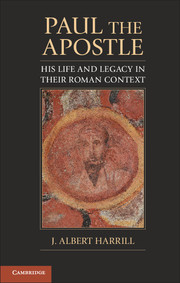Book contents
- Frontmatter
- Contents
- Figures and Boxes
- Preface
- Introduction
- PART I The Life
- 1 From Pharisee to Apostle
- 2 Communities in the Making
- 3 Paul's Life in Its Roman Context
- PART II The Legend
- Appendix 1: Extant Writings Attributed to Saint Paul in Rough Chronological Order
- Appendix 2: Reconstructing Paul's Corinthian Correspondence: A Puzzle
- Appendix 3: Ancient Christian Works Containing Pauline Traditions and Legends
- Notes and Further Reading
- Bibliography
- Index of Biblical Citations
- Index
1 - From Pharisee to Apostle
Published online by Cambridge University Press: 05 November 2012
- Frontmatter
- Contents
- Figures and Boxes
- Preface
- Introduction
- PART I The Life
- 1 From Pharisee to Apostle
- 2 Communities in the Making
- 3 Paul's Life in Its Roman Context
- PART II The Legend
- Appendix 1: Extant Writings Attributed to Saint Paul in Rough Chronological Order
- Appendix 2: Reconstructing Paul's Corinthian Correspondence: A Puzzle
- Appendix 3: Ancient Christian Works Containing Pauline Traditions and Legends
- Notes and Further Reading
- Bibliography
- Index of Biblical Citations
- Index
Summary
Many people today, if they are familiar with the figure, believe that Paul lived a life full of paradoxes. Born and raised Jewish, and proud of it, he traveled in a “pagan” world with its different sensibilities. He felt compelled to adopt and then proselytize a faith he had formerly persecuted. He claimed to be an apostle of Jesus Christ, yet had neither met the Galilean peasant Jesus nor been one of his chosen Twelve Disciples. He did not think of himself as “Christian,” but he later became known as the key figure that established Christianity. He bore a Roman name (Greek Paulos, from the Latin Paulus) and apparently also a Jewish one (Saul, but it is only mentioned in the Acts of the Apostles). Attempts to heighten these paradoxes shape the most popular theme in Paul's biography; as scholars tell his story, they often try to resolve these paradoxes by saying that the Jewish “Saul” converted to become the Christian “Paul” and also repudiated his past life in Judaism. A closer examination of the evidence, however, shows a cultural continuity between Saul's early life in Judaism and Paul's later Christian mission. Paul and Saul cannot be bifurcated or divorced. Instead of underscoring the paradoxes between Paul's Jewish past and his later Gentile mission, I argue for continuity.
The sections in this chapter show this continuity in Paul's birth and education, his “conversion” at the city of Damascus in Roman Syria, and his contentiousness with Jesus’ original apostles.
- Type
- Chapter
- Information
- Paul the ApostleHis Life and Legacy in their Roman Context, pp. 23 - 45Publisher: Cambridge University PressPrint publication year: 2012



